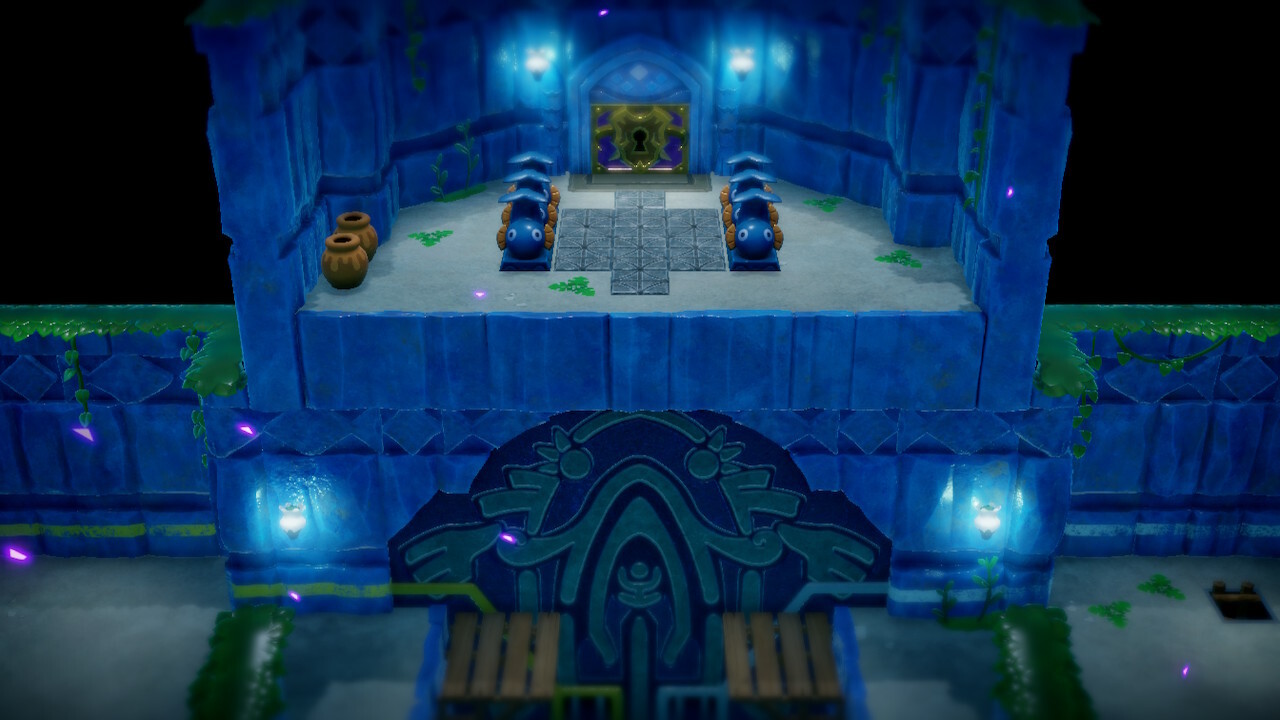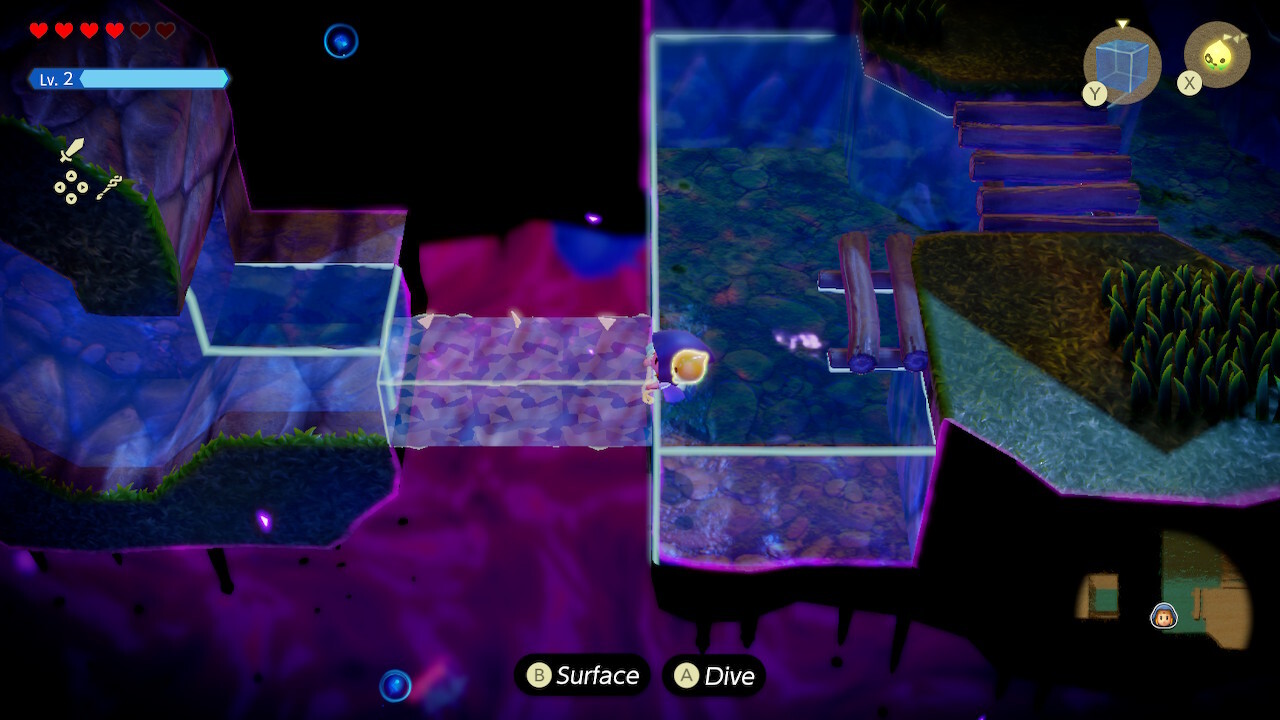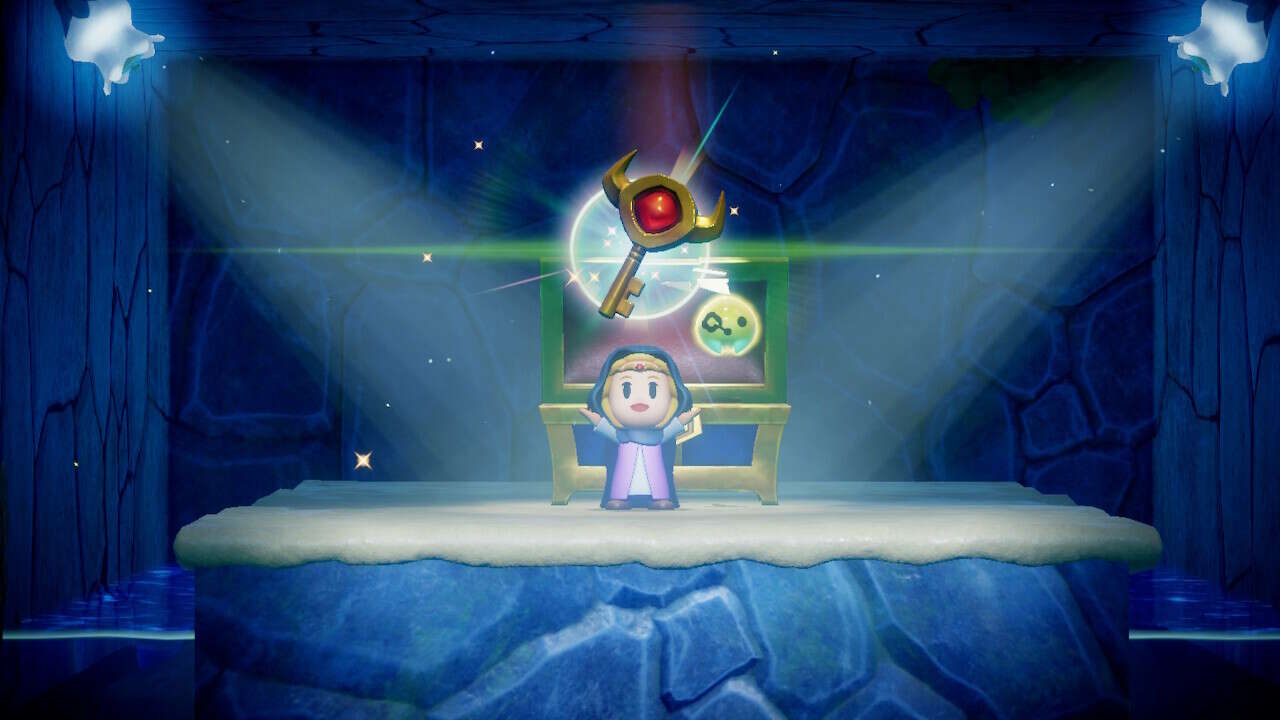The Legend of Zelda: Echoes of Wisdom offers a link between the two worlds of Nintendo’s iconic action-adventure franchise. It has the playfulness and freeform puzzles of Tears of the Kingdom and the traditional dungeon design the franchise was known for prior to Breath of the Wild’s seismic shake-up. Echoes of Wisdom deftly bounces from past to present and establishes its own identity, turning the page to start a new legend for Princess Zelda.
By now, you’re probably well-aware that the major change here is that the franchise namesake is finally the playable character. Technically, the Philips CD-i game Zelda’s Adventure was the first to do this, but that abysmal game was nothing like Nintendo’s Zelda games–it wasn’t even published by Nintendo. Echoes of Wisdom is the first proper game starring Zelda, which sounds rather ridiculous when you consider the fact that Tingle has starred in three games and a multi-function DSiWare app where you can have your fortune read by the creepiest dude from Hyrule.
From a narrative perspective, the role reversal makes little impact, largely because Echoes of Wisdom is light on story. A malevolent force is creating rifts across Hyrule that turn residents of Hyrule, including Link and Zelda’s father, into statues inside the dark and dreary dimension known as the Still World. Much like how Link was accused of wrongdoing in A Link to the Past, Zelda is accused of creating the rifts and is subsequently imprisoned; you’ll even find Wanted posters around Hyrule, this time showing Zelda’s face instead of Link’s. In her cell, she meets Tri, an ethereal being who accompanies Zelda on her quest and is essentially Zelda’s version of Navi from Ocarina of Time. Though some express momentary shock that Zelda is the kingdom’s only hope, she is mostly viewed as the one person capable of defeating the evil threatening to consume Hyrule.
While the rote plot is a hodgepodge of familiar stories, Echoes of Wisdom is more focused on shaking things up from a gameplay standpoint. The shift to playing as Zelda includes markedly different systems for combat, puzzle-solving, and platforming–yes, Echoes of Wisdom has plenty of platforming. Armed with a magical staff given to her by Tri, Zelda can spawn “echoes,” copies of objects and enemies you encounter across Hyrule. Outside of bosses, every enemy can be conjured as an echo. Since Zelda is incapable of attacking directly, friendly echo monsters serve as the main form of offense. Each echo has a cost, and going beyond your current max deletes the oldest echoes you created. Because there isn’t a cooldown period and you can manually wipe the slate clean at any time, this seemingly passive combat system is far more active and exciting than it initially seems. Once I started racking up echoes and was able to use more at once, I started to enjoy the organized chaos more than any pre-Breath of the Wild combat system.
Player choice is paramount to the combat system. Much like Tears of the Kingdom and Breath of the Wild, there’s no “wrong” way to vanquish enemies. Do you want to create rocks and hurl them at your enemies repeatedly? You can do that. Command Zirros to spew bombs everywhere? Check. Create a deathring of Pathblades that slice those armored Moblins and Lizalflos while you take a nap on a bed and regenerate health? It’s an effective strategy. Zelda does get to wield Link’s traditional weapons in Swordfighter Form, though this is tied to an upgradeable energy gauge. When used in combination with echoes, Swordfighter Form is a powerful complementary mechanic that adds another layer to the organized chaos of Echoes of Wisdom’s combat.
Gallery
Monsters make up the majority of the 127 echoes, but an assortment of inanimate objects combined with Zelda’s ability to jump serve as the connective tissue of this thoughtfully designed iteration of Hyrule. Without the Tri Rod, this version of Hyrule simply wouldn’t work. Going all-in on one central mechanic really helps Echoes of Wisdom feel markedly different than any other Zelda game. The end result is a top-down Legend of Zelda game with more freedom than ever before.
Unlike Link in other top-down entries, Zelda doesn’t need Roc’s Feather/Cape to jump (she should teach him). With this unprecedented ability, you can hide inside of pots and hop around to avoid detection by castle guards in an early stealth sequence that nods back to Ocarina of Time. Much of Echoes of Wisdom’s platforming involves building makeshift stairs and bridges. This central concept is taught effectively here with end tables, wooden crates, decorative trees, and the most absurd echo of all: beds. Twin-sized beds can be stacked to form bridges and towers. Seeing four beds stacked across small islands in Lake Hylia or above molten lava in the Fire Temple is a rather curious sight. Even funnier is spawning a bed in the middle of a boss fight to take a nap and gradually restore health.
Similar to Tears of the Kingdom’s Ultrahand rune, Tri can latch onto and move echoes. It’s a more rudimentary system, as you can’t turn objects and you aren’t required to make wonky contraptions with multiple moving pieces. Mostly, you’re stacking objects to cross gaps or using echoes to solve puzzles. My favorite and most-used traversal echo was the water block found while helping the Zoras calm down a creature long-time Zelda fans will surely remember. Water blocks can be stacked vertically or horizontally to create towers and tunnels to swim through. It’s superb for platforming sequences and solving puzzles, but it’s also a great example of the versatility of echoes. Since flying monsters can’t live in water, you can create an above-ground pool and drag them in, which kills them instantly. Similarly, you can lure enemies into the flames of torches placed in the center of a room to deal with them. Finding these numerous ways to guide enemies to certain death with the help of echoes is one of the game’s many joys.
The robust echoes system rewards experimentation and encourages exploration. You’ll want to pay close attention to your surroundings for objects that sparkle, signifying they can be copied. Trampoline echoes can help you reach areas before upgrading the Tri Rod, and if you’re adept at platforming, the disappearing cloud echoes can be used to cross large sections of the map without ever touching the ground. You can also hitch a ride by choosing to follow, rather than guide, monster echoes. For example, birds take you airborne and sharks pull you through strong underwater currents. Although these monsters are now friendly, when you choose to follow them, you are not in control of their movements. Not by default at least. If you poke around, talk to people, and complete side quests, you’ll learn new tricks that can fundamentally alter the way you approach platforming sequences and puzzles.
Nintendo struck a great balance of old and new with Echoes of Wisdom’s structure and overarching level design. The lead-up to dungeons takes cues from Tears of Kingdom with multi-part quests, including a trip to the Still World to find Tri’s friends and clear the corrupted stretch of land. These scavenger-hunt sequences feel like smaller versions of Tears of the Kingdom’s dungeons. Resembling a cross between the Sky Islands and the Depths, the Still World is a shadowy platforming playground with segmented islands and more aggressive monsters. Rifts do an excellent job teaching you the “rules” of the region as you approach the dungeon at the end of the darkness.
Tears of the Kingdom’s temples were certainly closer to traditional dungeons than the Divine Beasts from Breath of the Wild, but they still strayed pretty far from the old formula. Echoes of Wisdom’s seven dungeons bring back the classic template of multiple floors, automatically shutting doors with rooms full of monsters, small keys to find, and a big chest with the boss key. Besides Hyrule Castle, they retain elemental themes, such as Faron Temple (Forest), Lanyru Temple (Ice), and Jabul Ruins (Water).

Gallery
One of the biggest strengths of these dungeons is how familiar puzzles with ground switches, torches, and other franchise staples feel radically fresh. Instead of finding a new piece of gear to solve puzzles, you utilize new objects and monsters. Even the side-scrolling sections, which were rather straightforward in Link’s Awakening and the Oracle games, are clever riddles to solve. Puzzle complexity does a wonderful job of scaling with you. As you progress, the number of echoes you can create at once increases, and the cost of conjuring some of them drops. Despite having the cute toy-like visual style of Link’s Awakening, puzzles can get pretty darn challenging. In fact, some of them stumped me for longer than any puzzle in Breath of the Wild or Tears of the Kingdom. Figuring out solutions provided the same satisfaction as solving a really clever logic puzzle. And like all good logic puzzles, you can approach each puzzle from different angles. When comparing strategies with another GameSpot staffer, it was fascinating to see how differently we arrived at solutions.
Combat isn’t as challenging as the pair of open-world Zelda games, but it’s possible to get wrecked pretty quickly if you don’t spawn monsters that match up well with the enemy, especially in boss fights, which are lengthier and more challenging than dungeon bosses from other top-down Zelda games. Even early bosses, such as the flying mole-like creature wearing sunglasses in the Gerudo Ruins, can be tricky because of its fast underground movements and quicksand that makes some monsters incapable of putting up much of a fight. Though I never died while fighting a boss, I had to heal to stave off the Game Over screen on numerous occasions.
Classic-style dungeons are flanked by a plethora of side quests a la Breath of the Wild and Tears of the Kingdom. While some side quests can be as small as showing an echo to someone, there are numerous high-score-chasing minigames, combat challenges, and errands that require you to explore new areas and solve puzzles. Numerous useful echoes and items are earned through side quests. Borrowing horses from Hyrule Ranch and getting your own are tied to side quests, too. Yes, for the first time, a top-down Zelda game has horseback riding, and the steeds are extremely cute, albeit not super practical. Though probably the largest top-down Zelda game in terms of map size, Echoes of Wisdom has a generous fast-travel system, with multiple warp points in each zone. And since Hyrule is tailored around the echo system, I often found myself abandoning my horse to explore a point of interest inaccessible on horseback.
Finding hidden collectibles has always been a major component of Zelda games, and Echoes of Wisdom brings back the best collectible of all: Heart Pieces. The return of the signature collectible emphasizes how Echoes of Wisdom represents two eras of Zelda games. There are 40 Heart Pieces scattered throughout Hyrule, and a good chunk of them are obscured by some of the trickiest puzzles on hand. Defeating bosses rewards you with a Heart Container and an upgrade to the Tri Rod. Outside of Heart Pieces, you’ll find Might Pieces which can be exchanged for upgrades to Zelda’s Swordfighter Form. Some of these are unmissable, but a lot are tied to side quests and exploration, so there’s ample incentive to seek these out. The third collectible introduces the weirdest character not named Tingle: Stamp Guy, an obsessive stamp collector, wants you to love stamps as much as he does. I searched for stamps largely to see what he would do after filling up each stamp card. His pure love and devotion needs to be witnessed.
Multiple other modern new-era series fixtures are adopted by Echoes of Wisdom. It borrows the interactive map system with identical objective markers and reference pins to drop at points of interest. Each area of Hyrule is obscured until you visit it, which is a simple way to remind players exploration is key. The menu and quick-menu structure mirrors those games, too. Scrolling through 100-plus echoes can be somewhat cumbersome, but you can sort them within five different parameters, including most/last used, which helps streamline the process. Instead of cooking meals, you can visit Deku smoothie shops. Mixing materials like fruits and monster parts into a wide selection of drinks lets you replenish hearts and provide stat buffs like resistance to cold, fire, increase dive time, damage resistance. Some materials can only be found by completing certain minigames or by exploring outside of the main questline, offering yet another reason to carefully survey your surroundings. Though Zelda doesn’t have as many outfits as Link, there are two main ones and at least a few cute garments earned through side quests and by scanning Amiibo figures.
Zelda gets two main outfits and there are at least several optional ones to uncover through side quests and general exploration. I unlocked two by scanning Amiibo figures. Outfits can, but don’t always, modify attributes in small ways. Optional accessories provide more noticeable ability bumps and overarching buffs, including the ability to jump higher or hold your breath underwater longer as well as increase drop rates for items such as crafting materials and rupees. The gear system skews toward the classics rather than the RPG systems of modern Zelda games, and this works well since echoes serve as your “build.”

Gallery
If you played the Link’s Awakening remake, you already know that Echoes of Wisdom has gorgeous, colorful visuals. Unfortunately, it also shares Link’s Awakening’s intermittent frame-rate issues, albeit to a lesser extent. It’s a larger game with a lot more moving pieces, so it’s clear optimizations to the engine were made. Critically, I never noticed slowdown when conjuring echoes–even when throwing eight of them on the map in rapid succession. The slowdown, like Link’s Awakening, appears to be tied to rendering the world map.
Nearly the entire map is accessible from the start, though you’ll need to upgrade the Tri Rod to reach collectibles and solve certain puzzles throughout the overworld. Main quests can be completed in the order of your choosing, at least to a certain extent. After the first dungeon, you can head to either Gerudo Desert or Jabul Waters to help the two Zora factions. These first three dungeons (called Ruins) reminded me of Ocarina of Time’s Young Link phase. The mid-game dungeon is the same for everyone before opening up with three different paths for the larger temples.
Being able to explore freely and bounce around between quests for a change of scenery makes Echoes of Wisdom feel like a semi-open-world adventure. Unfortunately, the path I went down in my first playthrough led to a full-on game-breaking bug that placed an invisible barrier at the entrance of Goron City. Since you need to go inside to complete the Eldin Temple main quest, I was left with no choice but to abandon my 35-hour save file, which included numerous hours of troubleshooting without success, and start again. GameSpot informed Nintendo of the bug, and we will update this review if we can confirm it has been fixed. It’s worth noting my colleague did not encounter this issue. Though I don’t know what caused the bug, here’s what I did during my second playthrough: I started the main quest in Kakariko Village and proceeded straight to Goron City before touching any of the optional content in the region.
With only one dungeon and the final area remaining, the bug required me to make use of the second save slot far sooner than I normally would in a Zelda game. If there’s a silver lining to abandoning 35 hours of playtime and starting from scratch, it’s that I gained a greater appreciation for the versatility of echoes and developed new strategies that made replaying each dungeon as interesting as the first time, for a different reason. Obviously the thrill of learning how to solve many of the puzzles was gone, but optimizing my play style with learned strategies made me enjoy the second playthrough almost as much as the first. Rather than walking in my own footsteps, I often unconsciously gravitated toward new solutions.
My total playtime eclipsed 65 hours, but if I had been able to complete the game during my first playthrough, I likely would have rolled credits around the 30-hour mark. It’s not Tears of the Kingdom or Breath of the Wild big, but Echoes of Wisdom is larger than many fans would likely expect from a top-down Zelda game.
If Zelda’s debut in the spotlight is a one-off, at least it’s a memorable adventure. But hopefully this is the beginning of a new legend for the heroine. Echoes of Wisdom’s brilliantly integrates echoes system links two eras, proving that the freeform mechanics of the new age can coexist with the franchise’s classic formula. Don’t mistake this for a spin-off or minor entry between big “mainline” games: The Legend of Zelda: Echoes of Wisdom is a major moment that shouldn’t be missed.
